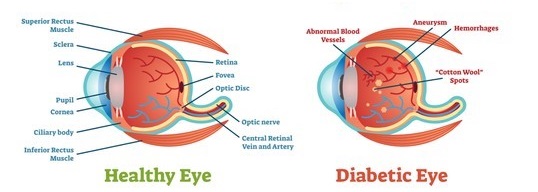| Catalog# | Product Name | Size | Price | Qty | Inquiry |
|---|---|---|---|---|---|
| THP-0295 | Endostatin | 1 vial | $3,998.00 |
|
Add to Cart Order |
Diabetic retinopathy is a complication of diabetes, caused by high blood sugar levels that damage the back of the eye (retina). Anyone with diabetes can develop this disease. If left untreated, it may lead to impaired vision or even blindness.
In the early stages of diabetic retinopathy, patients have vascular leakage in the retina. This manifests itself as fluid, hemorrhage, or lipids in the retina. Eventually, these blood vessels close leading to local ischemia or poor blood flow. As the disease progresses, abnormal blood vessels can grow due to ischemia. These abnormal vessels can leak blood into the vitreous humor that fills the patient's eye and cause tractional changes in the retinal surface detaching it and leading to severe vision loss in later stages.

Disruption of the blood-retinal barrier (BRB) is one of the important pathological changes in the pathogenesis of diabetic retinopathy. Similar to the blood-brain barrier, BRB selectively regulates the microenvironment of retinal nerve tissue, vascular permeability and homeostasis, ion concentrations, and transported metabolites. In addition, BRB can limit the entry of immunoglobulins, albumin, and circulating immune cells into the neural retina and can protect retinal nerve tissue from inflammatory cells and cytotoxicity in the blood. BRB plays an important role in regulating the local microenvironment of the retina and maintaining retinal homeostasis.
Vascular endothelial growth factor (VEGF) is associated with the destruction of BRB in diabetes. It is a vascular permeability factor that increases vascular permeability by inducing the phosphorylation of calretinin and tight junction proteins. VEGF levels are significantly elevated in the vitreous of diabetic eyes, while VEGF protein and mRNA levels are also significantly elevated in the retina. High VEGF expression in diabetic patients induces neointima formation and BRB breakdown. These newly formed vessels are more fragile and more likely to rupture, leading to more neovascularization, massive hemorrhage, and vision loss.
Endostatin is one such anti-angiogenic agent currently under investigation. Due to the inhibition of VEGF expression, endostatin has emerged as one of the most potent endogenous angiogenesis inhibitors. The downregulation of VEGF may be one of the mechanisms by which endostatin works. This may provide researchers with a new approach to anti-angiogenic therapy for diabetic retinopathy.
To date, endostatin has been shown to inhibit up to 65 different types of tumors. In addition, it can down-regulate angiogenesis in various pathological types, as it can induce modifications in about 12% of the human genome. Considering its application as an angiogenesis inhibitor, it may be approved as an effective agent for anti-angiogenic therapy.
Angiogenesis is one of the most aggressive features in the pathogenesis of proliferative diabetic retinopathy. Endostatin has shown a protective effect against diabetic retinopathy in a rat model of diabetes mellitus. Modern therapies are looking for a way to prevent angiogenesis to prevent eventual blindness in patients with diabetic retinopathy, and endostatin is an effective molecule for prevention. Creative BioMart offers endostatin products to customers to help them with their diabetic retinopathy studies. Please feel free to contact us to bring new hope to patients with diabetic retinopathy.
For more information on how our products could help advance your project, please contact us.
ENTER YOUR EMAIL HERE TO SUBSCRIBE.
Copyright © 2025 Creative BioMart. All Rights Reserved.